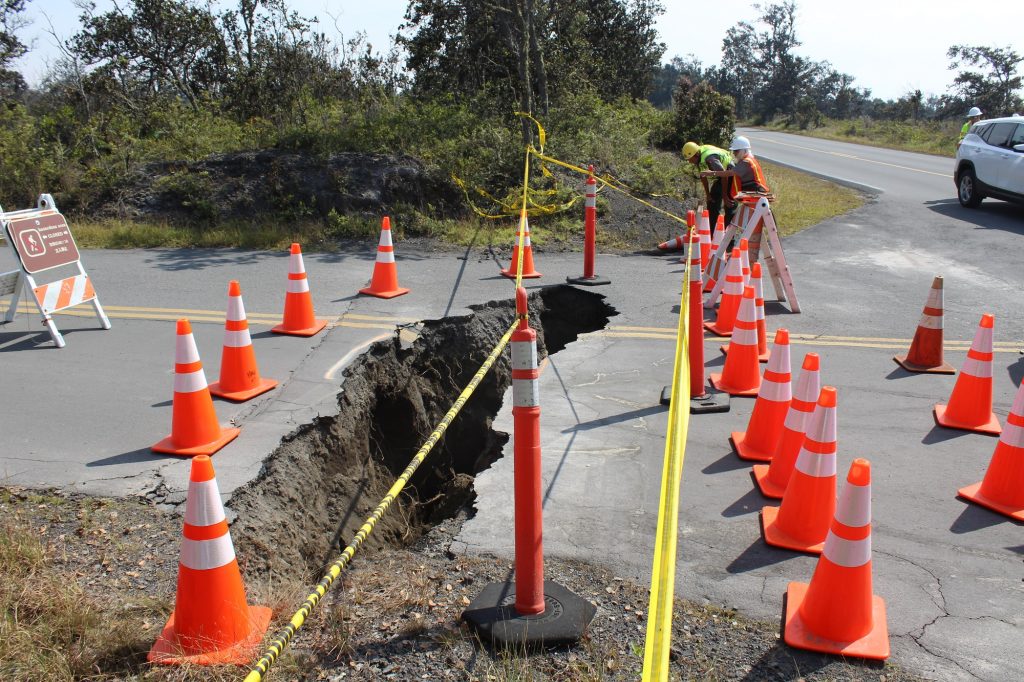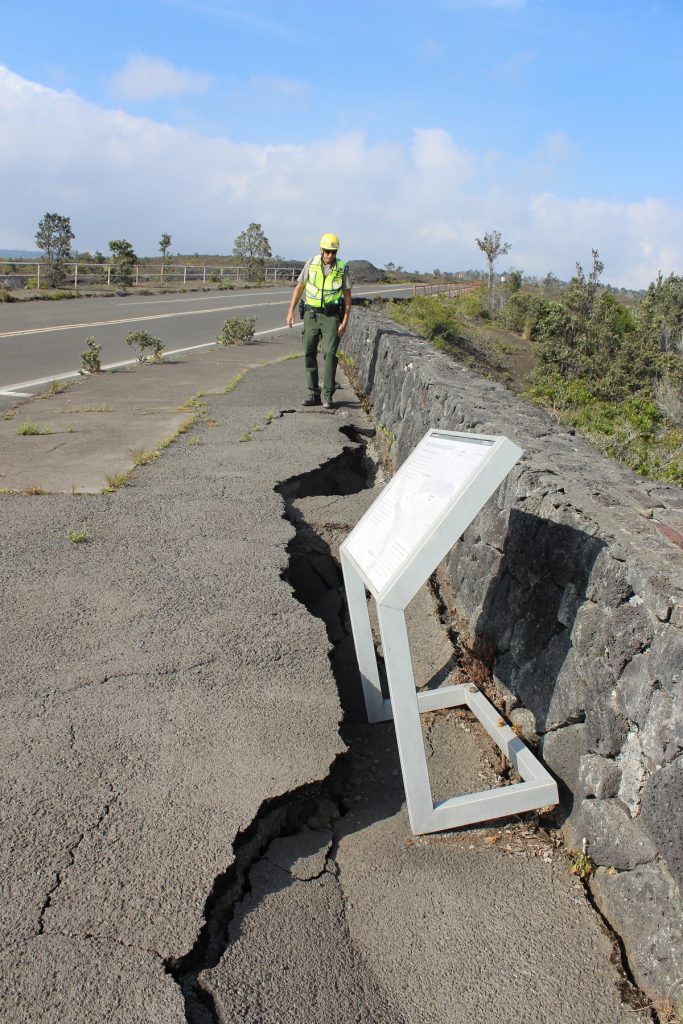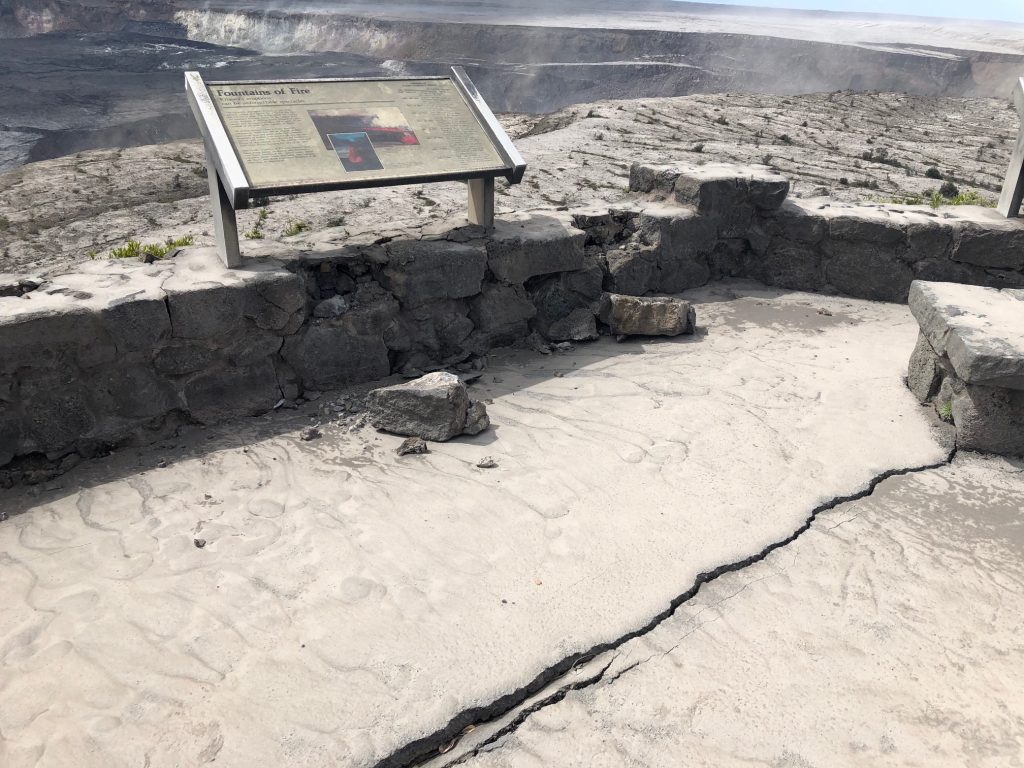Sink Holes, Cracks Riddle Hawai‘i Volcanoes National Park
Although seismicity decreased over the weekend, frequent tremors over the past 30 days (more than 18,000) have caused damage throughout the Hawai‘i Volcanoes National Park.
Much of the Hawai‘i Volcanoes National Park has been closed three months due to hazards caused by by seismic activity released by energy from collapse events at the summit of Kīlauea Volcano.
Park rangers say those magnitude 5.0 and higher riddle Highway 11, other park roads, overlooks and trails with dangerous sink holes and cracks.
Jaggar Museum and the USGS Hawaiian Volcano Observatory buildings are damaged and stand empty. The summit crater, Halema‘uma‘u, has more than quadrupled in size as magma drains out to the lower East Rift Zone eruption outside the park.
Rangers have called the new dimensions “staggering.” Once 280-feet deep, Halema‘uma‘u is now more than 1,500 feet deep in places. Its volume has increased to 800,000,000 cubic meters, according to USGS, an amount equivalent to about 300,000 Olympic-sized swimming pools.
Without lava pressure supporting the summit, large and sudden collapses have reshaped Hawai‘i Volcanoes National Park.
More than 60 large collapse/explosion events have occurred since the park closed on May 11. “The earthquakes also increase the risk of fire: broken waterlines have left most of the park without running water for fire suppression. Fixing them makes little sense as long as the earthquakes continue,” Park officials said.
Scientists say the activity could last months, even years. “Only when the destructive earthquakes subside will the park be able to fully assess damages, clean up the mess and develop a strategy to reopen,” according to NPS officials.
“It’s impossible to say when the park can reopen, what it’s going to look like and what the visitor experience will be. We are cautiously optimistic that seismicity decreased over the weekend,” said Park Superintendent Cindy Orlando. “Everyone’s safety is our top priority and we are still in an unpredictable and hazardous phase of this eruption cycle. Right now, the only certainty is uncertainty,” she said.
Large sink holes and fractured asphalt on Highway 11 are being repaired by state highway workers, often necessitating one-lane closures and a reduced 25 mph speed limit. Government agencies are working together to create alternate and emergency routes should the highway fail. But the fate of park features like Thurston Lava Tube are unknown because it’s too risky to send anyone inside to take a look.
“We miss being in the park, we miss sharing Hawai‘i Volcanoes National Park with visitors from around the world and across the street. We realize the extended closure is very hard on our community and disappointing to travelers. It’s hard on all of us, and we appreciate everyone’s continued understanding and support,” Orlando said.
While scientists cannot predict exactly when the eruptive and seismic activity will end, Hawai‘i Volcanoes National Park invites everyone to explore how a volcanic landscape snaps back to life. In the park’s Kahuku Unit, gorgeous ‘ōhi‘a trees spring forth from Mauna Loa Volcano’s 1868 flows. Native birds, including crimson ‘apapane forage among the blooms. ‘Io, the Hawaiian hawk, and the short-eared owl, pu‘eo, are sometimes seen soaring above.
Ranger-guided hikes at Kahuku reveal the link between volcanoes and all life in Hawai‘i. On the two-mile Nature & Culture hike, visitors are inspired how hulihia (catastrophic change) and kulia (restoration) are correlated. Kahuku, which is located an hour’s drive south of the park’s main entrance, is open Wednesday through Sunday from 9 a.m. to 3 p.m. and entrance is free.
Rangers also offer new and familiar programs at the park’s Kahuku Unit, Mokupāpapa Discovery Center in Hilo, the Volcano Art Center’s Niaulani Campus in Volcano Village and other locations – free of charge.

Overlook puka. PC: NPS/USGS.

Overlook crack. PC: NPS

Deep crack on Jaggar Museum Overlook. PC: NPS.

Kīlauea Iki boulder. PC: USGS












